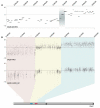FoSTeS, MMBIR and NAHR at the human proximal Xp region and the mechanisms of human Xq isochromosome formation
- PMID: 21349920
- PMCID: PMC3428953
- DOI: 10.1093/hmg/ddr074
FoSTeS, MMBIR and NAHR at the human proximal Xp region and the mechanisms of human Xq isochromosome formation
Abstract
The recently described DNA replication-based mechanisms of fork stalling and template switching (FoSTeS) and microhomology-mediated break-induced replication (MMBIR) were previously shown to catalyze complex exonic, genic and genomic rearrangements. By analyzing a large number of isochromosomes of the long arm of chromosome X (i(Xq)), using whole-genome tiling path array comparative genomic hybridization (aCGH), ultra-high resolution targeted aCGH and sequencing, we provide evidence that the FoSTeS and MMBIR mechanisms can generate large-scale gross chromosomal rearrangements leading to the deletion and duplication of entire chromosome arms, thus suggesting an important role for DNA replication-based mechanisms in both the development of genomic disorders and cancer. Furthermore, we elucidate the mechanisms of dicentric i(Xq) (idic(Xq)) formation and show that most idic(Xq) chromosomes result from non-allelic homologous recombination between palindromic low copy repeats and highly homologous palindromic LINE elements. We also show that non-recurrent-breakpoint idic(Xq) chromosomes have microhomology-associated breakpoint junctions and are likely catalyzed by microhomology-mediated replication-dependent recombination mechanisms such as FoSTeS and MMBIR. Finally, we stress the role of the proximal Xp region as a chromosomal rearrangement hotspot.
Figures



References
-
- Skaletsky H, Kuroda-Kawaguchi T, Minx PJ, Cordum HS, Hillier L, Brown LG, Repping S, Pyntikova T, Ali J, Bieri T, et al. The male-specific region of the human Y chromosome is a mosaic of discrete sequence classes. Nature. 2003;423:825–837. - PubMed
-
- She X, Horvath JE, Jiang Z, Liu G, Furey TS, Christ L, Clark R, Graves T, Gulden CL, Alkan C, et al. The structure and evolution of centromeric transition regions within the human genome. Nature. 2004;430:857–864. - PubMed

